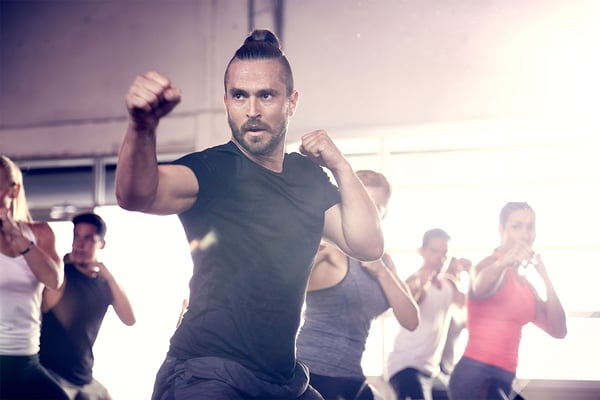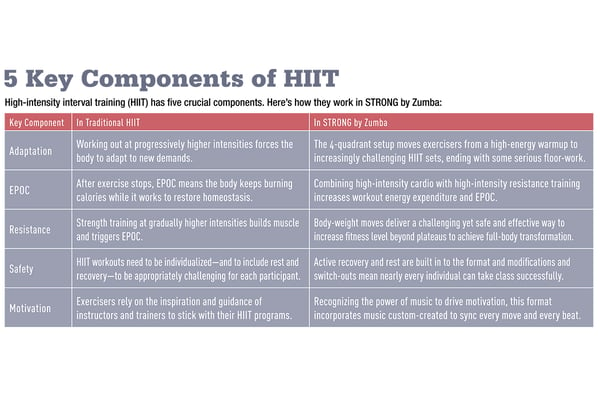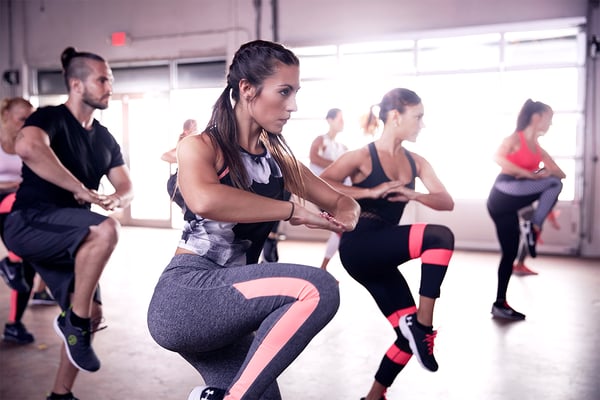
High-intensity interval training (HIIT) has rich potential for delivering results to our members. Indeed, the science-backed benefits of HIIT have propelled it into increasing numbers of group-exercise schedules-notably because it helps people get better results in less time. In 2016, the creative minds at Zumba decided to bring HIIT to their legions of fans worldwide.
The result was STRONG by Zumba®, a music-driven, sweat-inducing version of HIIT group exercise that's appealing to at least four kinds of fitness professionals:
- Zumba instructors looking to add STRONG classes
- Group fitness instructors looking for an opportunity to add HIIT classes
- Group instructors looking for already curated music and choreography in the HIIT space
- Personal trainers looking to add a HIIT format to their repertoire
The Basics of HIIT

Before we dive into the specifics of STRONG by Zumba, let's review the fundamentals of HIIT.
High-intensity interval training is versatile enough to meet the distinct needs of a diverse population of exercisers, but not all HIIT formats are created equal. The strenuous, compound nature of these exercise routines requires that they be designed properly and taught correctly to prevent injuries. High-quality HIIT workouts should do the following well:
PROMOTE SPECIFIC ADAPTATION
The principle of specific adaptation to imposed demands (SAID) is that the body eventually adapts to the stress put on it. If you don't challenge yourself, you won't change. In group exercise, it's easy to promote SAID by altering variables such as resistance, intensity, training methods and movement choice.
"An important component of programming is including options for increasing physical demands to continually help participants make fitness gains," says Stacey Penney, MS, NASM-CPT, CES, PES, FNS, content strategist for the National Academy of Sports Medicine. "This allows participants to avoid plateaus and maximize results."
STIMULATE EPOC
Excess postexercise oxygen consumption is the amount of oxygen the body must use to restore its normal state (homeostasis) after a workout. "Think of it as the extra energy it takes to run the air conditioner to cool the house down after the oven has been on," says Penney.
"Metabolic and interval training offer great EPOC boosts, and the perk of EPOC is that it results in extra calories being burned for hours after the workout is finished."
Intense exercise stimulates EPOC. As you exercise at higher intensity levels that lead you farther from your pre-exercise state, your body has to expend more energy to return to homeostasis. During recovery, the body rapidly attempts to return to "normal," greatly elevating energy expenditure.
ADD RESISTANCE
Resistance training is critical to achieving muscular definition, strength and endurance. As we become stronger, so do our workouts, making future workouts more effective. Research suggests that high-intensity resistance exercise disturbs homeostasis more than cardiovascular exercise does, causing a larger energy requirement and higher EPOC (Reynolds & Kravitz 2001).
Hence, HIIT workouts combining cardio and strength training further encourage adaptation and the EPOC effect.

EMPHASIZE SAFETY
HIIT workouts are strenuous, but if done properly, they can be effective for most apparently healthy individuals. "Intense exercise" can be individually defined. For instance, some people may find a low-impact jumping jack to be intense enough to elevate the heart rate to a challenging level, while others may need a traditional jack.
Participants requiring even more can do plyometric jacks turning in a circle. A well-programmed HIIT workout should allow modifications to be easily applied to all movements and/or segments, meeting the diverse needs of members.
And don't neglect recovery. "Encouraging rest and recovery is an important component of programming to avoid exhaustion," Penney says. "You can't perform at your best if you are stressing your body all the time."
MOTIVATE PARTICIPANTS
Motivation keeps people coming to our classes. As program directors and instructors, we need to choose formats that attract participants and keep them motivated during class. It's a mutually dependent relationship:
Movement choice, instructor demeanor and, of course, music are huge motivators. A group exercise format should remain simultaneously fun and effective to keep attracting participants and pushing them harder to reach their goals.
A STRONG Approach to HIIT
If you're looking for a new and exciting addition to your HIIT offerings, STRONG by Zumba is worth a look. First, make sure you understand that STRONG is not a dance class like traditional, cardio-driven Zumba: It's a science-based HIIT format synced with music to create a unique full-body workout.
"STRONG by Zumba is not just a new program, it's a HIIT experience," says Darren Jacobson, senior vice president for instructor programming at Zumba. In this HIIT format, cardio, plyometrics and resistance-style body-weight exercises are all synced with music to motivate class participants to push harder. As Jacobson puts it: Your clients get "a challenging yet safe and effective way to increase their fitness level beyond plateaus to achieve full-body transformation."
Synced music is integral to the STRONG philosophy. "The moves and routines are first created, then this content with no music is sent to our producers, who then create the music to fit the moves-every move, every beat-to drive and enhance the class experience and boost motivation," Jacobson says.
"We use this reverse-engineered process of creating music to drive home the fact that music can make you work at an entirely different fitness level.
"In most fitness classes, it is the opposite: Music is given to the instructor and moves are then developed or choreographed to that music," Jacobson says. Zumba teamed up with top music producers like Timbaland and Steve Aoki "to revolutionize high-intensity training."
Zumba spent 2 years crafting STRONG before launching it in 2016. The end product encompasses all the necessities of proper HIIT design, creating the potential for a safe, effective, results-driven workout that attracts traditional Zumba fans as well as those who want a pure HIIT experience.

Here, the workout routine is generated first, then the music is created to fit every step, lunge, burpee and crunch.

Fusing high-intensity cardio with high-intensity body-weight fires up energy expenditure and torches calories postworkout, too.

The Flexibility of STRONG
STRONG by Zumba classes consist of four distinct quadrants with specific goals designed to build the workout's intensity progressively and systematically: Quadrant 1: Ignite (a warmup), Quadrant 2: Fire Up (HIIT exercises), Quadrant 3: Push Your Limits (combos or supersets of Fire Up moves) and Quadrant 4: Floorplay (core and other floor exercises). The intense nature of the workout and varying modes of exercise encourage SAID and EPOC, ultimately improving results.
"We implemented STRONG by Zumba as soon as it was released, and now it's a successful class on our schedule," says David Harper, a 25-year industry veteran and regional director of group fitness for Crunch Fitness in Central Virginia and Charleston, South Carolina. "It's important for me to implement formats in our clubs that encourage cross-training to prevent overuse injury and achieve maximum results. In that sense, STRONG by Zumba is a great addition to our schedule."
The STRONG format's resistance component relies on body weight, helping the classes attract participants who may be intimidated by strength training, as well as those who enjoy resistance training but not necessarily traditional weightlifting.
"I really like the body-weight training component of this workout," says Karen Hodges, certified STRONG by Zumba instructor at B.R. Ryall YMCA in Glen Ellyn, Illinois. "With body-weight training, people don't even realize that they are weight training, yet still gain all the benefits."
Moreover, body-weight exercises such as pushups, burpees and plank jacks are tough enough to interest the hard-core, athletic crowd, including the male market that is a challenge for group exercise programs to attract.
Most importantly, the STRONG format stresses safety, focusing on recovery and making it easy to modify programming. Active recovery is built into the format, with rest periods after each of the four quadrants. It's also designed so it can be changed to suit individual needs.
"As an instructor, you can easily adapt the workout to all fitness levels by modifying the exercise selection with switch-outs and modifications so that nearly everyone can take the class, be successful and progress," says Jacobson. Hodges agrees: "I can easily adjust each quadrant by modeling the modification before the more intense movements."
Popularity Rising
From January 2017 to date, STRONG by Zumba has seen a 180% growth in the number of classes added to club schedules. In its first year, tens of thousands of instructors have been trained in over 115 countries, says Jacobson. And you don't have to buy additional equipment.
"Budget can be a major factor when considering new formats for our clubs," says Harper. "I am always looking for formats that don't require new equipment purchases." Furthermore, like all Zumba programs, there are no license fees that gyms need to pay. The cost to be a STRONG by Zumba instructor is paid by the individual instructor who holds the license.
"I have a lot of fun teaching STRONG by Zumba," Hodges says. "The beat of the music is motivating, and it drives my class and me to work harder. I love seeing members reach their fitness goals."
If you're interested, Jacobson says, look for the STRONG by Zumba Master Class tour coming to a city near you, check out a live class, visit strong.zumba.com, or email gyms@zumba.com for more information.
References
Reynolds, J.M. & Kravitz, L. 2001. Resistance training and EPOC. IDEA Personal Trainer, 12 (5), 17–19.
STRONG by Zumba at a Glance
>> A full-body HIIT workout that combines cardio, resistance and plyometric exercises
>> Music-driven, with beats and rhythms composed to sync with the movements
>> Designed to be adaptable to needs of diverse exercisers
>> Body-weight resistance that is attractive for those who aren't interested in weightlifting
>> Completion of SBZ Training earns 8 AFAA CEUs
Quote: In STRONG by Zumba, cardio, plyometrics and resistance-style body-weight exercises are all synced with music to motivate class participants to push

